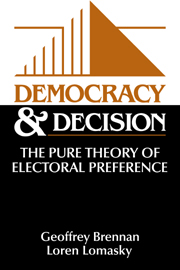Book contents
- Frontmatter
- Contents
- Preface
- 1 Ethics, politics, and public choice
- 2 The logic of electoral choice
- 3 The nature of expressive returns
- 4 The analytics of decisiveness
- 5 The theory of electoral outcomes: implications for public choice theory
- 6 From anecdote to analysis
- 7 Interpreting the numbers
- 8 Consensus, efficiency, and contractarian justification
- 9 Paternalism, self-paternalism, and the state
- 10 Toward a democratic morality
- 11 Constitutional implications
- Bibliography
- Index
11 - Constitutional implications
Published online by Cambridge University Press: 05 June 2012
- Frontmatter
- Contents
- Preface
- 1 Ethics, politics, and public choice
- 2 The logic of electoral choice
- 3 The nature of expressive returns
- 4 The analytics of decisiveness
- 5 The theory of electoral outcomes: implications for public choice theory
- 6 From anecdote to analysis
- 7 Interpreting the numbers
- 8 Consensus, efficiency, and contractarian justification
- 9 Paternalism, self-paternalism, and the state
- 10 Toward a democratic morality
- 11 Constitutional implications
- Bibliography
- Index
Summary
What should governments be allowed to do? What is the appropriate sphere of political action? How large a share of national product should be available for political disposition? What sort of political decision structures should be adopted at the constitutional stage? Under what conditions and to what extent should individuals be franchised?
These questions and many others like them clearly depend for answers on some positive, predictive analysis of how different political institutions will operate. An informed and meaningful theory of constitutions cannot be constructed until and unless there exists some theory of the operation of alternative political rules.
James Buchanan, “Politics Without Romance”The normative dimension
How extended should the domain of politics be? Should democracy be representative or direct? What is the case for a federal as opposed to a centralized polity? How should power be distributed among the various parts of the state apparatus? What are the pros and cons of bicameralism?
Such questions are the very stuff of political theory, whether in the public choice variant or in the more traditional form familiar from political science and political philosophy. Whatever other ambitions it may have, political theory aspires to provide the resources for evaluating alternative ways of organizing political life.
Of course, public choice – and more generally political theory in the rational actor tradition – goes about its normative theorizing in a distinctive way. It imports from economics an attempted dichotomy between “positive” and “normative” analysis, and it embodies that dichotomy in a kind of two-stage procedure for normative theorizing.
- Type
- Chapter
- Information
- Democracy and DecisionThe Pure Theory of Electoral Preference, pp. 199 - 225Publisher: Cambridge University PressPrint publication year: 1993



